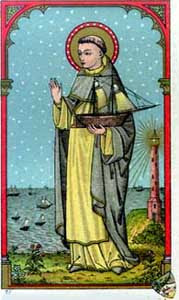St. Adjutor

He was born near Normandy, France, where he was made a knight in the First Crusade. The stories given for his patronage of boaters vary. Some state that he was captured by Muslims in The Crusade, and escaped persecution by swimming. Additional legends state that it was in fact angels who freed him from his captors, and his association with the seas came when he calmed a whirlpool by throwing Holy water, and the chains of his captivity into it, and signing the cross. He returned to France and entered the abbey of Tiron. There he became a recluse, remaining recollected until his death of April 30.






























